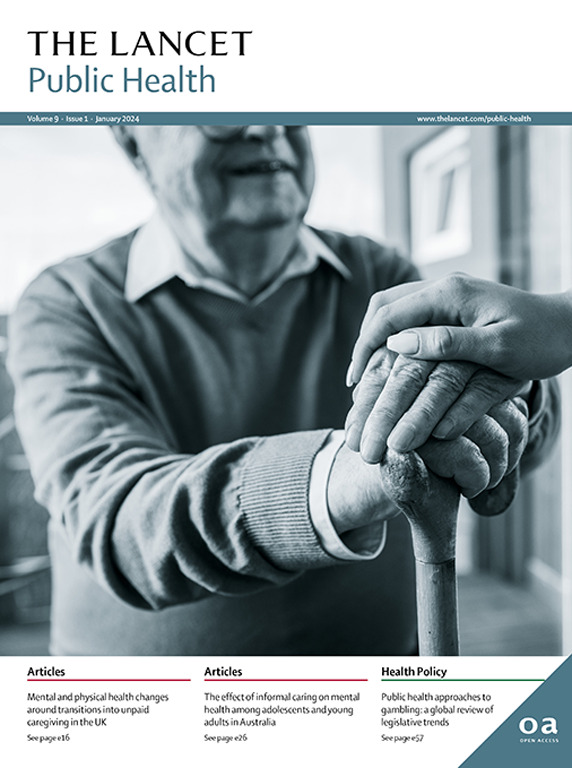2000 - 2020年国家、区域和全球酒精消费和相关疾病负担统计数据:模型研究和比较风险评估
IF 25.2
1区 医学
Q1 PUBLIC, ENVIRONMENTAL & OCCUPATIONAL HEALTH
引用次数: 0
摘要
关于酒精消费和相关健康危害的数据对于评估实现全球卫生目标的进展至关重要。本研究旨在估计2000年至2020年的全球酒精消费量,以及2000年至2019年的全球酒精相关危害负担。方法在这项全球分析中,成人人均消费数据估算是基于销售、调查和旅行者数据建模的。通过对174个国家540项调查的回归分析,估计了饮酒状况和过去30天的重度间歇性饮酒。使用比较风险评估方法,通过将酒精消费数据与从荟萃分析和队列研究中获得的相应相对风险相结合,估计酒精归因危害。死亡率和发病率数据来自世卫组织《全球卫生估计》。在全球范围内,2019年成年人的平均饮酒量为5.5升(95%不确定区间为4.9 - 6.2),比2000年的5.1升(4.6 - 5.7)有所增加。从2019年到2020年,酒精消费量下降到4.9 L(4.3 - 5·6)。2019年,酒精消费与260万(230万至110万)例死亡(占所有死亡人数的4.7%)和1.16亿残疾调整生命年(DALYs)损失(占所有DALYs损失的4.6%)相关。与酒精消费相比,2000年至2019年,酒精导致的死亡人数下降了31.0%,每10万人损失的伤残调整生命年下降了27.4%。酒精造成了很大的疾病负担,这对东欧、撒哈拉以南非洲中部和南部的人们以及年轻人造成了不成比例的影响。因此,这些区域应实施诸如增加酒精税、减少可获得性和限制营销等政策,以减少与酒精有关的危害。本文章由计算机程序翻译,如有差异,请以英文原文为准。
National, regional, and global statistics on alcohol consumption and associated burden of disease 2000–20: a modelling study and comparative risk assessment
Background
Data on alcohol consumption and associated health harms are essential to evaluate progress in achieving global health goals. This study aims to estimate global alcohol consumption from 2000 to 2020, and the global burden of alcohol-attributable harms from 2000 to 2019.Methods
In this global analysis, adult per capita consumption data estimates were modelled on the basis of sales, survey, and traveller data. Drinking status and past 30-day heavy episodic drinking were estimated through regression analyses of 540 surveys from 174 countries. Alcohol-attributable harms were estimated using a comparative risk assessment methodology by combining alcohol consumption data with corresponding relative risks obtained from meta-analyses and cohort studies. Mortality and morbidity data were obtained from WHO Global Health Estimates.Findings
Globally, average alcohol consumption in 2019 among adults was 5·5 L (95% uncertainty interval 4·9–6·2), which increased from 5·1 L (4·6–5·7) in 2000. From 2019 to 2020 alcohol consumption decreased to 4·9 L (4·3–5·6). In 2019, alcohol consumption was associated with 2·6 (2·3–3·1) million deaths (4·7% of all deaths) and 116·0 million disability-adjusted life-years (DALYs) lost (4·6% of all DALYs lost). In contrast to alcohol consumption, the number of alcohol-attributable deaths decreased by 31·0% and DALYs lost per 100 000 people decreased by 27·4% from 2000 to 2019.Interpretation
Alcohol is attributed to a large burden of disease, which disproportionately affects people in Eastern Europe and in Central and Southern Sub-Saharan Africa, and young people. Accordingly, these regions should implement policies such as alcohol taxation increases, availability reductions, and marketing restrictions to reduce alcohol-related harms.Funding
WHO.求助全文
通过发布文献求助,成功后即可免费获取论文全文。
去求助
来源期刊

Lancet Public Health
Medicine-Public Health, Environmental and Occupational Health
CiteScore
55.60
自引率
0.80%
发文量
305
审稿时长
8 weeks
期刊介绍:
The Lancet Public Health is committed to tackling the most pressing issues across all aspects of public health. We have a strong commitment to using science to improve health equity and social justice. In line with the values and vision of The Lancet, we take a broad and inclusive approach to public health and are interested in interdisciplinary research.
We publish a range of content types that can advance public health policies and outcomes. These include Articles, Review, Comment, and Correspondence. Learn more about the types of papers we publish.
 求助内容:
求助内容: 应助结果提醒方式:
应助结果提醒方式:


